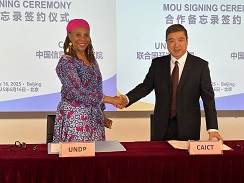By Africa Risk Control,NBE
Copyright newbusinessethiopia

By Africa Risk Control East Africa Desk – Kenya, often referred to as the “Silicon Savannah,” has emerged as East Africa’s leading hub for technology and infrastructure development.
With a population exceeding 53 million and a rapidly growing economy of approximately US$120 billion in 2024, Kenya offers investors a wealth of opportunities across fintech, ICT (information and communications technology), e-commerce, renewable energy, transport, and urban development.
Urbanization is proceeding at roughly 4% annually, and the median age is just 20 years, creating a young, digitally savvy workforce and consumer base. These dynamics, combined with Kenya’s well-developed mobile money ecosystem and growing ICT sector, make it an attractive investment destination for both local and international investors.
Technology Sector: Opportunities and Key Players
Kenya’s technology ecosystem is among the most advanced in Africa. The fintech (financial technology) sector, anchored by M-PESA (Mobile Payment Service) with over 34 million users, exemplifies the country’s capacity for digital innovation.
Digital finance adoption is widespread, with nearly 60% of adults using mobile wallets. Opportunities abound for investors in embedded finance platforms, digital lending, insurtech (insurance technology) solutions, and B2B2C (business-to-business-to-consumer) payment systems. Leading players include Safaricom (M-PESA), Tala, Branch, Cellulant, Jumo, and Equity Bank’s fintech arm.
Despite its promise, the fintech sector carries risks, including regulatory changes, cybersecurity threats, intense competition, and foreign exchange volatility. Investors can mitigate these risks through careful partner vetting, cybersecurity audits, and ongoing regulatory monitoring. Africa Risk Control supports investors in navigating these challenges through tailored due diligence and operational risk assessment.
The e-commerce sector is another high-growth area, projected to reach US$4.5 billion by 2025. Rapid urbanization, rising middle-class purchasing power, and widespread smartphone adoption (~87% of urban residents) are driving demand. Investment opportunities include last-mile delivery networks, cold-chain logistics, urban warehouses, and tech-enabled micro-fulfillment centers.
Prominent players in this sector include Jumia, Kilimall, Copia, Sendy, Glovo, and Twiga Foods. Key challenges include infrastructure gaps, logistical delays, regulatory hurdles, and competition. Mitigation strategies involve careful infrastructure assessment, phased entry approaches, and leveraging Africa Risk Control’s market intelligence.
ICT and BPO (business process outsourcing) services contribute approximately 5–6% of Kenya’s GDP. The sector offers opportunities in enterprise SaaS (Software as a Service) solutions for SMEs (small and medium-sized enterprises), cloud services, artificial intelligence (AI) platforms, and BPO operations. Notable players include IBM Kenya, Microsoft Kenya, Andela, iHub, Kenya Data Networks (KDN), and AccessKenya. Investors must navigate challenges such as talent shortages, fast-moving technology, and regulatory shifts. These risks can be managed with strategic workforce partnerships, technology audits, and compliance monitoring.
Infrastructure Sector: Opportunities and Key Players
Kenya’s infrastructure sector has benefited from large-scale projects such as the Standard Gauge Railway (SGR) and the LAPSSET (Lamu Port-South Sudan-Ethiopia Transport) Corridor, as well as extensive road and urban development initiatives. These projects provide investors with opportunities in public-private partnerships (PPPs), cargo terminals, last-mile logistics, fleet management, and tech-enabled transport solutions.
Key players include Kenya Railways, Kenya Ports Authority (KPA), Rift Valley Railways, Siginon Group, and Transcentury. Challenges such as construction delays, land disputes, and community resistance can be addressed through feasibility studies, stakeholder engagement, and comprehensive risk assessment.
The energy and renewables sector is expanding rapidly. Kenya boasts 2.4 GW of geothermal energy, 1 GW of wind capacity, and growing solar installations. Opportunities exist in grid-scale solar and wind projects, off-grid mini-grids for rural communities, industrial renewable power purchase agreements (PPAs), and battery storage solutions.
Leading companies include KenGen (Kenya Electricity Generating Company), Lake Turkana Wind Power, KenSol, Voltalia Kenya, and M-KOPA Solar. Investors face regulatory, financing, and technical risks, which can be mitigated through due diligence, partner vetting, and technical audits.
Urban development and affordable housing also represent major opportunities. Kenya’s urbanization rate of 4% annually has contributed to a housing deficit of approximately 2 million units. Investment possibilities include affordable and mid-income housing, eco-friendly construction materials, and urban planning services.
Prominent players include Shelter Afrique, Centum Investment, Cytonn Real Estate, Acorn Holdings, and Housing Finance Group. Risks such as land disputes, approval delays, and financing challenges can be mitigated with careful land and regulatory due diligence, phased financing strategies, and environmental/social assessments.
Key Risks and Mitigation
While Kenya offers tremendous potential, investors must account for several key risks:
Macroeconomic and Currency Risks: KES (Kenyan Shilling) volatility and inflation (~5–6%) can affect operational costs. Mitigation includes FX hedging and structuring revenues in local currency.
Regulatory and Policy Risks: Frequent updates in fintech, ICT, energy, and transport policies require careful monitoring. Early engagement with regulators and Africa Risk Control’s policy advisory can mitigate these risks.
Operational and Execution Risks: Incomplete infrastructure or project delays require phased implementation and rigorous partner vetting.
Political and Security Risks: Community resistance or urban unrest may disrupt operations. Stakeholder engagement and security assessments help reduce exposure.
Environmental and Social Risks: Land disputes and ecological concerns necessitate ESG (environmental, social, governance) frameworks and impact studies.
Market and Competition Risks: Rapid technological adoption and high competition require continuous market intelligence and strategic planning.
Key Figures and Metrics
Investors gain a clear picture of Kenya’s market potential through these key figures:
– Population: 53+ million, median age 20
– GDP: ~US$120 billion (2024), growth 5–6% annually
– ICT Contribution to GDP: 5–6%
– Mobile Money Users: 34 million+ (M-PESA)
– E-Commerce Market: US$4.5 billion projected by 2025
– Urbanization Rate: ~4% annually
– Housing Deficit: ~2 million units
– Renewable Energy Capacity: 2.4 GW geothermal, 1 GW wind, expanding solar
– Transport & Trade: Ports handle 80% of East Africa’s maritime trade
– SME Sector: ~80% of private-sector employment
– Financial Inclusion: Over 70% of adults with access to digital financial services
These metrics provide investors with a comprehensive understanding of Kenya’s economic and sectoral landscape, helping to identify high-growth opportunities and potential challenges.
Kenya’s technology and infrastructure sectors present high-growth opportunities across fintech, ICT, e-commerce, renewable energy, transport, and urban development. While the potential is significant, success depends on strategic planning, risk mitigation, and informed decision-making.
EDITOR’S NOTE: This Insight is produced by Africa Risk Control (ARC), which provides investigative due diligence, risk assessment, and actionable market intelligence to help investors make informed and secure investment decisions across Africa. ARC is an affiliate of NewBusinessEthiopia.com and provides expert country-specific business insights, risk assessments, and advisory services across Africa.
The contributions of ARC aims to help international investors navigate this dynamic landscape through investigative due diligence, risk assessment, and actionable market intelligence, ensuring that investments are informed, secure, and sustainable.



